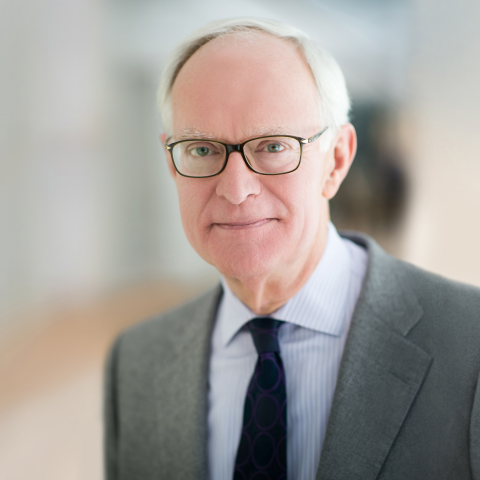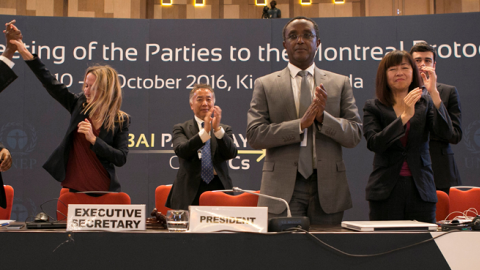Following is the executive summary of the February 5th, 2018 Hudson event titled Environmental Policy in the 21st Century: The Future of the Kigali Amendment.
Thomas J. Duesterberg, Hudson Institute Senior Fellow
The Montreal Protocol (formally, the Montreal Protocol on Substances that Deplete the Ozone Layer) is widely regarded as the model treaty for international cooperation on global environmental issues.
The treaty was negotiated for the United States by the Reagan Administration and approved by the U.S. Senate in 1987. Since then, it has been amended four times with the advice and consent of the Senate. In all, it has been ratified by 197 nations, including all United Nations member states.
Under the Montreal Protocol, many potent ozone-depleting chemicals have been phased out, and others are scheduled or proposed for phasing out in future years. While some dispute the treaty’s effectiveness in improving the environment, the ozone layer has clearly stabilized and begun to recover since the treaty was implemented. A key to the treaty’s success has been its provisions for making future adjustments. The most recent amendment to the Montreal Protocol is the Kigali Amendment, named after the capital city of Rwanda where it was agreed to at an international conference in 2016. The Kigali Amendment to the Montreal Protocol aims to phase out hydrofluorocarbons (HFCs), which have been used as an alternative to the ozone-depleting chlorofluorocarbons (CFCs) the original Montreal Protocol phased out. HFCs are now used widely in refrigeration and air conditioning. The trouble is that HFCs turn out to be extremely potent greenhouse gases believed to affect global warming.
The Kigali Amendment raises several important questions. For example, is the amendment both low-cost and effective at reducing greenhouse gas emissions, as proponents argue? Is it as effective as other, more controversial, approaches to global warming? Can it be implemented by the U.S. without amending the Clean Air Act, if it is submitted by the Trump Administration and approved by the Senate? These and related issues were the subjects of a conference convened at the Hudson Institute on February 5, 2018. A full transcript of the proceedings, which consisted of a keynote address and two panels, follows this executive summary.
Steve Forbes, the editor-in-chief of Forbes magazine, gave the keynote address. He provided a full endorsement of the Kigali Amendment, and recommended that the Trump Administration support the amendment and submit it to the Senate for ratification. He argued that the amendment will please Americans on both the political left and right: “For the U.S., it is an opportunity to grow the economy and create jobs while doing something good for the planet.” Forbes favors the regulatory approach which avoids imposing top-down directives, and instead sets goals for reducing HFCs while allowing industry flexibility on how to achieve them. He reminded the audience that the Montreal Protocol was a model of both bipartisan action and international collaboration, and he proposed that Kigali will offer the same level of cooperative effort. He also said that by setting a clear path for the transition to less harmful chemicals, the amendment gives industry the certainty it requires for major investments in new technology. Finally, he argued that U.S. industry has “first-mover advantage” in creating new technologies to replace existing HFC-based systems, giving America a competitive edge in a post-Kigali Amendment market.
After Forbes’ keynote address, the first panel discussed how the Kigali Amendment was established, legal questions pertaining to its ratification in the United States, the White House’s current thinking on it, and how it is perceived internationally.
Professor James Hammitt of Harvard University, an expert in cost-benefit analysis, noted that the “very long atmospheric lifetimes” of CFCs and HFCs, as well as their potent effect on the atmosphere, are the main reasons to address the problem without delay. He noted that the Montreal Protocol’s phase-out of CFCs set a good example for international cooperation and the effective use of regulation, as it allowed industry to find the most cost-effective ways to eliminate the relevant compounds, which resulted in good cooperation between industry and governments and led to economically efficient solutions. Hammitt also highlighted how Montreal set up a system of emissions trading credits, allowing low-emitting developing nations to trade credits to the developed countries who are the main producers and users of CFCs. This promoted cooperative efforts between developed and developing countries instead of acrimony and demands for expensive subsidies. According to Hammitt, Kigali promises to bring advantages similar to the original Montreal Protocol, and it already enjoys the support of industry and almost all nations.
Dave Banks, a member of the White House National Economic Council until March 2018, who was charged with overseeing international aspects of energy and environmental policy, provided a view into the White House’s thinking on Kigali. He stated at the outset that his own thinking on the issue is guided by the President’s stated number-one priority, namely, to “protect and enhance U.S. competitiveness, particularly in the manufacturing sector.” Banks said that he and his colleagues are studying ways to find the right balance between improving the environment and creating jobs and growth in the U.S. industrial sector. He noted that American firms are still leaders in the chemical and machinery technologies that are used in refrigeration equipment and are well-positioned to remain leaders if they must transition to new chemicals and to related equipment that does not rely on HFCs. He stated that the White House is still studying the legal issues surrounding the amendment, as well as the economics of moving to new technologies.
Jeff Holmstead, a partner at Bracewell LLP and the former Director of the Office of Air and Radiation at the Environmental Protection Agency (EPA), gave an overview of the legal status of the Kigali Amendment. The major question is whether the Senate will be required to amend the Clean Air Act to ratify the Kigali Amendment. He argued that no further legislation would be required if the Senate ratifies Kigali because Title VI of the Clean Air Act leaves room for amendments to the original Montreal Protocol. In the case of any adjustments to Montreal, such as the need to limit replacement chemicals or ban certain classes of chemicals, Title VI provides the necessary flexibility. Although a recent court case raised doubts that Kigali is compatible with the Clean Air Act since it specifically addresses the climate change impact of HFCs and not the ozone-depleting impacts, Holmstead nonetheless argues that both Title VI and the legislative history make clear that there will be no impediments to Kigali’s implementation. Holmstead predicted that if the President backs the Kigali Amendment, it will easily pass in the Senate.
Marc D’Iorio, Director General of Industrial Sectors, Chemicals and Waste at Environment and Climate Change Canada, said that the Montreal Protocol was a model for international cooperation on global environmental issues for three reasons. First, the Protocol won widespread support when it was ratified. Second, it employed trading and regulatory tools which allowed developing countries to benefit from and support the agreement. Third, because of its regulatory flexibility and stability, it had the full support of industry. He noted that Kigali has a regulatory structure similar to the Montreal Protocol: it allows for a gradual phase-out of HFCs over a prolonged period and thus gives both developing countries and industry confidence that major disruptions can be minimized. He concluded by reminding the audience that 20 countries, including Canada, have already ratified the agreement and that it goes into effect in 2019.
The second panel covered the economic aspects of the amendment as well as questions about its potential effectiveness to ameliorate the environmental problems associated with HFCs.
Paul Camuti, the Chief Technology Officer of Ingersoll Rand, addressed the industry’s efforts to find new technologies to replace the HFC systems. He said that what drives innovation and investments in the $100 billion-per-year refrigeration market are: regulatory certainty, size of markets, and the potential of new technologies to raise living standards and achieve consumer acceptance in both developing and developed countries. He noted that since Kigali is already going into effect, the regulatory environment in much of the world is already set, whether the United States ratifies the amendment or not. By ratifying the amendment, U.S. firms would be well-positioned to lead the world in developing new technologies and to assure that standards set by other countries would not disadvantage them. He said U.S. firms are already investing in the new systems and chemicals needed to achieve the Kigali targets, and that many of the new systems will be more energy efficient than the current generation. Such efficiencies are large enough to offset any higher costs for replacement chemicals for HFCs, and the cost of replacements will come down as markets grow and efficiencies of production are developed.
David Doniger, Senior Strategic Director of the Climate and Clean Energy Program at the National Resources Defense Council (NRDC), began by noting that cooperation between industry and the environmental community on the ozone issue has been exemplary for over 30 years and that the two are already working together to secure ratification of Kigali. When discussing the legal situation of the amendment, he observed that from the very beginning in the 1980s, it was recognized in Montreal and the Vienna Convention, that CFCs and “these classes of chemicals are not simply ozone depleting,” but have “other health and environmental effects.” Both Vienna and Montreal, and the Clean Air Act, he argued, give explicit authority “to attend to the side effects” of these chemicals. He agreed with Holmstead that no new legislative authority is required after the Kigali Amendment is ratified.
Patrick Michaels, Director of the Study of Science at the Cato Institute, argued that the environmental benefits of the Kigali Amendment are likely much more limited than official estimates predict. Most estimates on the Kigali Amendment’s impact in reducing the warming effect of HFCs center around 0.5 degrees Celsius. Using a variety of models and comparing those outcomes to recorded temperature increases in the 20th and 21st centuries, Michaels concluded that a reduction closer to 0.16 degrees Celsius is more likely. He also questioned whether the Montreal Protocol on ozone depletion even covers the impacts of greenhouse gases. Michaels presented slides that are reproduced in Appendix A.
Stephen Yurek, President and CEO of the Air-Conditioning, Heating and Refrigeration Institute (AHRI), stated that industry is fully behind Kigali because it outlines a clear path to developing technologies to replace HFC-based systems, and that the regulatory structure allows industry adequate flexibility to achieve the most cost-effective and energy efficient solutions. Yurek emphasized the latter point, saying that the savings from more energy efficient systems would more than offset the higher costs of introducing new technologies, which in any case will be phased in over a long period of time. He noted as well that, unlike the 2015 Paris Agreement, Kigali does not give undue subsidies or other advantages to developing countries such as China and India. He also emphasized that the amendment does not dictate technology solutions, but instead allows industry to innovate to find the best paths to phase out HFCs.
The discussion over how the United States should approach the Kigali Amendment will continue and intensify in the coming months. It is Hudson Institute’s hope that the expert insights that were shared at the “Future of the Kigali Amendment” conference, which are memorialized in the following pages, will help inform a thoughtful debate.

















